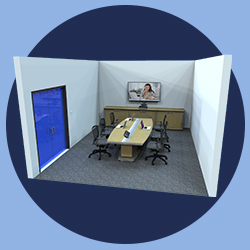Meetings are essential to effective collaboration in the workplace. From our home office to the conference room, the way we work is changed forever. More and more companies have remote employees, while conference room AV in the office has remained essential for employees outside the physical space to remain connected in every aspect of the business.
A poor room layout can adversely impact meeting outcomes. The right audio/visual solutions are critical to the efficiency of meetings, whether you are hosting a meeting, physically present in a meeting room, or remotely connected via phone or videoconferencing. Here are a few things to consider while designing a conference room.
- DISPLAY: The first thing people notice when walking into a conference room is the display. This is the “visual” part of conference room AV and is one of your main collaboration tools. The display enables you to see colleagues in other locations. Maximize the possibilities by showing content and presentations, on high-quality projection systems and digital displays, within your conference room. Single Display & Dual Displays – Single displays are the most common choice for many small conference rooms. Dual displays are a popular option, especially for companies that are heavy video-call users.
- VIDEO CONFERENCING: Videoconferencing opens doors to easy and effective communication between employees, clients, vendors, and guests. Video conferencing can save your company valuable time and money and is essential to the meeting room. Most platforms provide Outlook and Google integrations for easy meeting scheduling, while Zoom and Teams offer tools for enterprise connectivity. LED Video Walls are the best backdrop for your large meeting rooms, huddle rooms, boardrooms, and conference rooms. In conference room settings, LED video walls can transform the space and help enhance presentations during meetings.
- AUDIO CONFERENCING: Audio is the second piece of the meeting room communication. While some companies are comfortable going all-in with video calls, others still want the option for audio conferencing. It is common to have both audio and video conferencing technology in a single room. The audio equipment in your conference room AV setup should consist of more than simple speakers and a laptop microphone. Space and ambient noise greatly impact sound quality in video conferencing. Poor audio equipment, especially in a room not designed well for video conferencing.
Having the right systems in place and communicating clear expectations will not only improve how you conduct meetings every day, it will also elevate the workplace experience. When it comes to your conference rooms, huddle rooms, or large boardrooms, the quality of the audio/visual systems within your space has a direct correlation to the effectiveness of the meeting.
LaunchMyRoom is a simple platform to plan your audio-visual systems and was created for technology planners, architects, and consultants who want to set budgets, order rooms, and view system capabilities. Complete solution designs are what make LaunchMyRoom so convenient. To try out this tool for yourself, visit www.launchmyroom.com.





